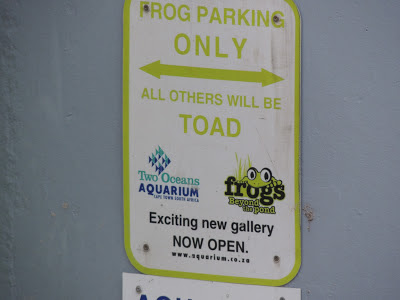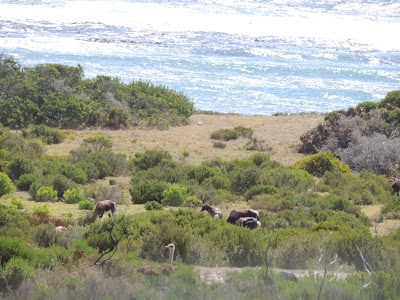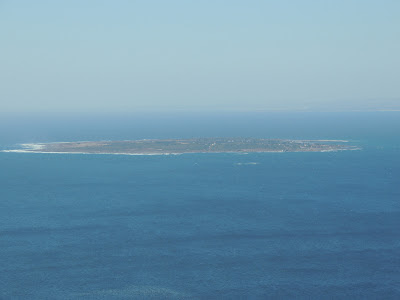We three - Pat, Kathy and I - rose early in the morning and Kathy drove us to Bloemfontein, where we caught a flight on Mango airlines (their planes are painted mango orange). We picked up our rental car and drove into the city, finding our way to the Verona Lodge, where we three stayed during our time in Cape Town (and where Kathy had stayed nine years ago).
After checking in, we wandered just a few short blocks to a local restaurant that one of our hosts at Verona had recommended, a place called Richard's.
We had a very satisfying meal, then went off in search of the starting point for our initial Cape Town excursion, the hop-on/hop-off bus tour run by City Sightseeing. This was a great introduction to the city, and a wonderful way to learn about Cape Town's geography and history. While we were waiting to board the bus, I saw this wonderful old ship out in the harbor.
The tour took us to the Victoria and Alfred Waterfront district (the Waterfront), which features shopping and restaurants, but is right up against the "working" part of the harbor. The giant red figure is actually constructed from old Coca Cola crates (which apparently make great giant-sized Legos).
Saw this sign outside the aquarium.
One of the great things about Cape Town is that if you cannot see the ocean, then you can see its other dominant feature, the mountains.
This includes Table Mountain, which I can confirm is much larger and more imposing than it looks here.
The bus took us through the heart of town, which was one of my favorite parts of the tour. Downtown Cape Town is vibrant and eclectic.
And the architecture is a grand mix of classic and modern.
We also went past the Castle of Good Hope, constructed in the 17th century. Very cool.
In the Grand Parade, I noticed this statue being forced to endure quite an indignity.
The bus took us up to the bottom of the cable car run that carries people to the summit of Table Mountain. We did not go up that first day (though we did another day), but the location provided an excellent opportunity to catch Pat and Kathy against the backdrop of Cape Town and its harbor.
We then wound our way down into Camps Bay, which is apparently the hot spot to see and be seen. I do not know about that, but the surf was worth seeing.
As were the clouds that appeared to have been laid across the mountain range like a blanket.
The housing along this stretch of coast is definitely high density, but I would be willing to give it a try.
After the tour, we decided we had had a long enough day that we would just get take-away (it is not called "take out" or "to go" here but "take away") from a local restaurant and eat back in our rooms. We selected the Cape to India restaurant, where the decor had as much to do with our decision to get our food to take away as did our exhaustion. It was very unappealing. But as is the case with many such dimly lit holes in the wall, the food was the key, and it was delicious.
Next day, we were bound for Cape Point. Along the way, we stopped in Muizenberg, a local mecca for surfers.
And we simply had to stop in Simon's Town to admire the African penguins. There is nothing quite like seeing such creatures in their natural habitat.
And in case you were wondering, penguins are as adorable as you think they are.
The scenery along that stretch of coast is quite fantastic.
Along with being a geographical feature, Cape Point is also a nature preserve with views so stunning we had to pose in front of them.
Here, Pat braves the rising tide to set foot in new waters.
At one stop during our investigation of the preserve, we caught sight of this Cape Sugarbird. (One of the more unexpected wonders of Southern Africa has been its birds.)
When we arrived at Cape Point lighthouse, we rode the funicular to the top.
Where the views were rather spectacular.
After descending from the lighthouse, we hit a bit of traffic.
But we eventually got the Point proper, which is the most southwestern point in Africa. There, some birds were enjoying the surf.
Then, some more traffic.
But ostriches and baboons were not the only wildlife we encountered at Cape Point, where - I must confess - I had not anticipated spotting any wildlife at all. In a field along the road we saw these bontebok.
And then we saw bontebok and ostriches relaxing seaside together. (Look closely. That little periscope at the front of the picture is an ostrich keeping a look out.)
But perhaps my favorite animal encounter at Cape Point occurred when we arrived at a quiet little bay and decided to get out of the car to stretch our legs and wander about a bit. There, in a field between the car and the sea, were this family of bontebok.
They were grazing surprisingly close to us. There is no feeling like knowing that there is nothing between you and a beautiful, wild creature. There is no wall. There is no fence. You are just sharing its natural habitat. (I felt like a bit of an intruder, really.)
The bay itself was lovely.
And upon closer inspection it featured some fascinating birds: the African Sacred Ibis.
On the way back from Cape Point, we stopped at a farm village in Noordhoek to do some shopping and enjoy the atmosphere by sitting on some astroturf.
No, really. The lawn on which you see my beautiful wife reclining was a built-in advertisement for an astroturf company.
The views driving up along the coast from Noordhoek to Cape Town were spectacular, including these near Hout Bay.
We decided to stop in Camps Bay for dinner, where we selected a Thai restaurant with a rather nice view.
We enjoyed the food as well as the setting.
And I was quite taken by the enthusiasm of the surf.
During the short drive from Camps Bay to our lodging in Cape Town, we were treated to one of the most spectacular sunsets I have ever seen.
In the morning, we enjoyed breakfast in the tranquil back yard space at Verona Lodge.
Then we caught a ferry out to Robben Island, an island actually in Table Bay and easily visible from higher elevations in the Cape Town area.
Robben Island is most notable for its service as a prison island and is, in fact, where Nelson Mandela was held for 18 of his 27 years of imprisonment. Here, depicted in this photo mounted on a wall, are political prisoners arriving at Robben Island, where they could expect a harsh life of forced labor.
Educational tours are offered on Robben Island, which is now functioning as a museum and national preserve. Here, our guide is giving us a bit of the history of the place.
Before it was a prison, the island served as a leper colony. We passed a graveyard from that era on our tour.
One of the most remarkable locations on the tour is the quarry, where inmates endured their labor, but where they also met and talked in secret about their anti-apartheid cause, making plans for a better future.
Our guide was kind enough to let me out of the tour bus to take a picture of this sign, where Barack Obama apparently posed for a picture when he visited Robben Island while serving as a U.S. Senator.
An unexpected bonus to our visit to Robben Island was the views it afforded us of Cape Town and Table Mountain.
The white man on the motorcycle here is the only former Robben Island prison guard to return to work there now that it is an historical site.
Here, as at Cape Point, we encountered wildlife unexpectedly (at least it was unexpected for me). This time, it was springbok. We learned that Springbok and other game were originally put on the island so prison guards could hunt them.
One of the many things I did not know about Robben Island was that it was fortified during World War II.
Predominantly, though, the island is known for its most famous inmate, Nelson Mandela. Here is one of the cells he occupied during his term there.
The prison yard itself was, as one might imagine, bleak.
One of the most fascinating parts of the tour focused on Robben Island's less famous inmates. In many of the old cells, there was an object of some significance to the individual who had occupied that cell, along with a picture of the inmate. For example, this stapler was important to Thami Mkhwanazi because he used it to staple together pieces of paper for an informal newsletter he produced for his fellow prisoners.
Our guide for the prison portion of the tour was himself a former inmate, jailed on conspiracy charges by the former apartheid government of South Africa..
Just how deeply the racism permeated conditions at the prison was exemplified by this detailing of food rations.
On board the ferry that carried us to the island and back, we were shown videos documenting some of the history of apartheid and opposition to it. (The ferry ride was too rough for me to take any pictures.) Kathy and I talked about when we first became aware of apartheid, and how shocking it was that we were unaware of it for as long as we were. For myself, it was not until protests started on college campuses, insisting that those colleges and universities divest from South Africa, and popular musicians began speaking (and singing) out about it, that I began to pay attention.
As we docked back in the Waterfront area of Cape Town, several of us caught site of this sea lion basking in the afternoon sun.
We then went to explore the Company's Gardens (the Dutch East India Company began the garden in 1652), in downtown Cape Town.
After that we drove up to Signal Hill, where we were afforded a marvelous view of Robben Island.
And where Kathy and Pat were able to take their bearings.
The landward view, featuring Table Mountain, was worth a pause as well.
That evening, we dined at Addis in Cape, an Ethiopian restaurant in the heart of Cape Town. The decor was, as I understand it, traditional Ethiopian. That is, it featured low chairs and tables which served as a common eating surface, since Ethiopian cuisine is properly enjoyed communally.
The ambiance felt like something out of old Hollywood, which I loved.
The food was savory and scrumptious. I definitely need to learn to prepare some Ethiopian dishes!
.
Of course, I could not resist capping off my meal with some traditional Ethiopian coffee.
The next day began again with breakfast in the lodge's well-favored back yard setting. Our hosts were wonderful, and the other guests we met were warm and friendly. There was a family from Germany and a young man from France, who apparently owns a vineyard there and was in South Africa to explore their wine making operations. He also provided Pat and Kathy with an opportunity to spend the morning chatting in French.
After breakfast, we set off for Table Mountain, where we rode the cable car to the top.
The view looking up from the bottom of the cable car ride made the top look so small. (It is not.)
The view looking down from the cable car as we rode up made Cape Town look so small. (It also is not.)
The vistas afforded by the top of Table Mountain were spectacular, to say the least.
We humans were not the only ones enjoying them. These rock dassies and lizards had found quite the spot to relax.
The top of Table Mountain can feel like the top of the world.
As I said, Table Mountain is not small. We spent quite a while exploring it and the views it afforded.
Eventually, though, we had to catch the cable car back down.

































































































No comments:
Post a Comment